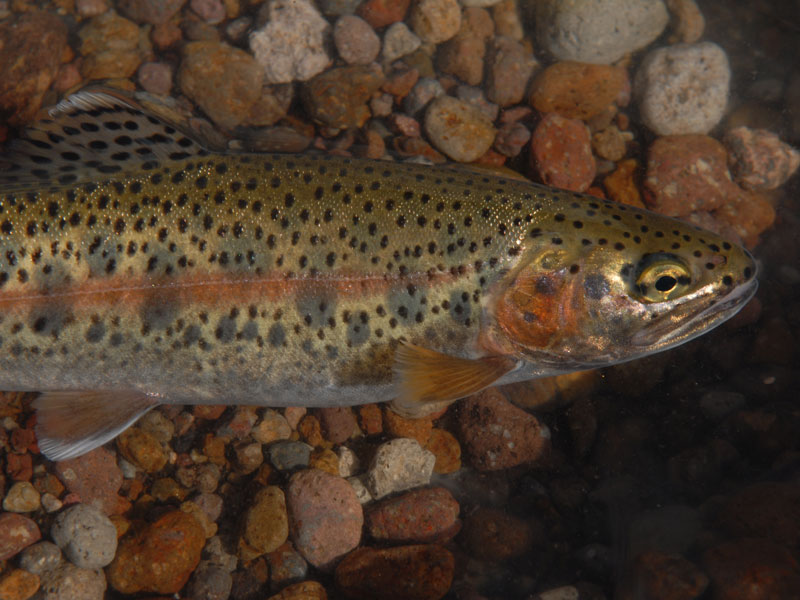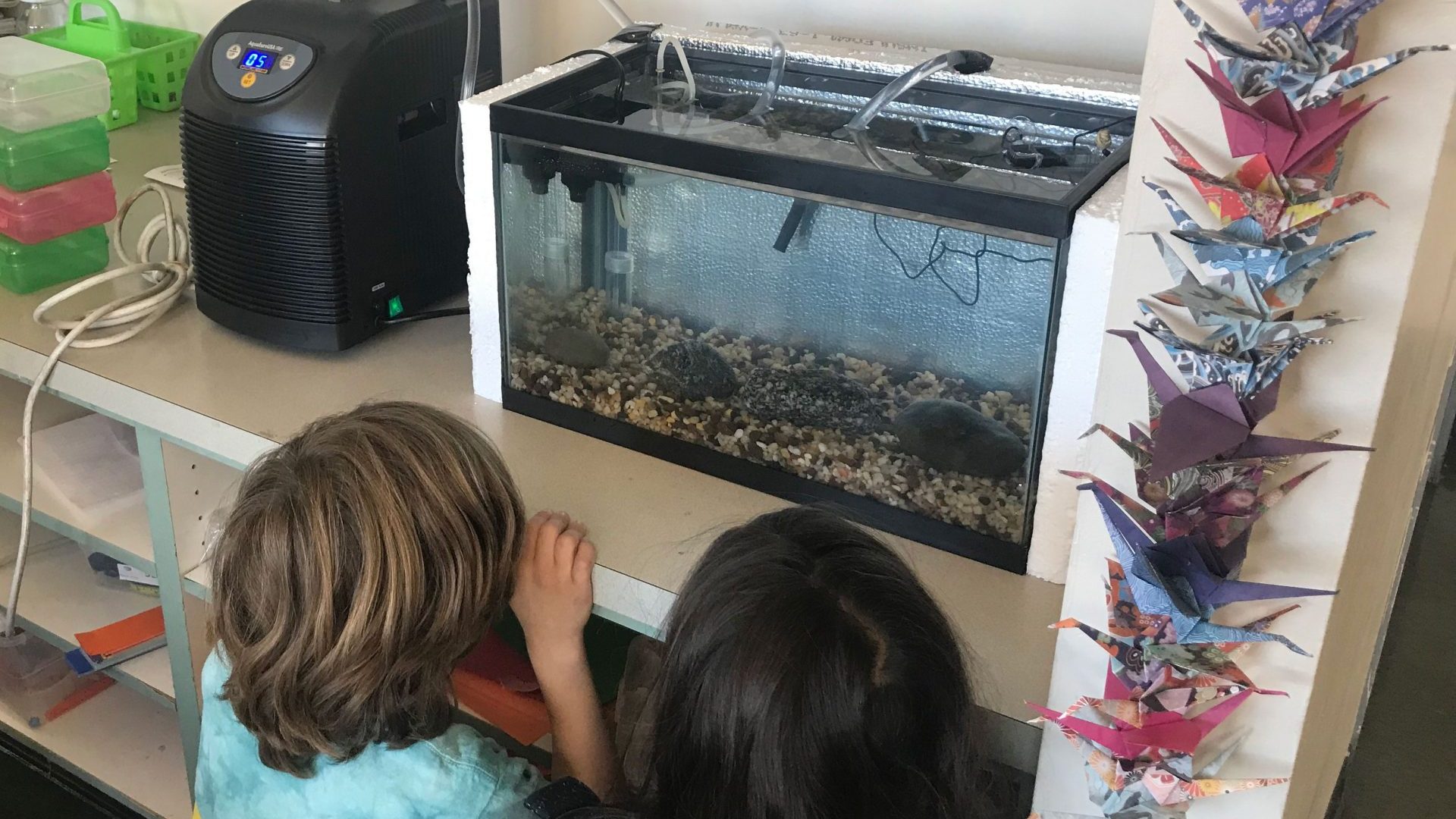By now, if you are a follower and supporter of California Trout, I’m sure you are aware that California has the greatest diversity of native salmonids of anywhere else in the lower 48.
The vast diversity of species and biomes are one of the features that makes California so unique. Eleven of our 32 distinct native salmonids are endemic trout populations. Nine of which have evolved into distinct sub-species because they have been isolated from anadromous travel and population-mixing in small and remote habitats for many centuries.
Due to the remoteness and small size of their existing habitats, some of our native, endemic inland trout are also some of the most threatened species we have here in California. Their reliance on small creeks with cold water put them on the front lines of the climate crisis and projected warming trends here in California. Some of our most sensitive species include the California golden trout, Little Kern golden, Kern River rainbow trout, Warner Mountain redband trout, Goose Lake redband, and the McCloud River redband. Each one of these species has a very limited range. Some of them only exist in one or two small creeks, which makes them especially vulnerable to climatic changes. One shift too far in one direction or the other could blink out an entire species. All these fish are extremely susceptible to severe events such as wildfire, flash flooding, mud slides, pollution, and poaching.
One of my favorite native inland trout is the McCloud River redband trout. This species is one of the most famous trout in history. They are the original broodstock that was used to transport rainbow trout all around the world- onto every continent. It can be argued that the McCloud River rainbow trout is the most prolific invasive aquatic freshwater species on the entire planet based on the number of places they have been placed and have established. But that famous McCloud trout from the main McCloud River is actually a part of the homogenized meta population of ocean-going rainbow trout and steelhead. The true and most pure strain of McCloud redband is only found in five streams isolated on the eastern flanks of Mount Shasta.
Those streams are all disconnected, meaning they flow out of the ground and then disappear again before they connect to any bigger systems. And they have been this way for all recorded history. That means these populations were isolated centuries ago after various volcanic and geological events cut these streams off. The result is that these fish were never hybridized with rainbows from other parts of California, but there also hasn’t been any genetic drift between the populations in a long time.

Photo: Craig Ballenger
In 2004 California Trout led a restoration project in partnership with the Forest Service and the Department of Fish and Wildlife on the biggest of the creeks containing McCloud redband- also the only population that has remained open to angling. If you are interested, I will let you do your own research on which creek that is. The restoration effort was two parts: meadow restoration and native fish habitat restoration. A long stretch of the meadow was restored; in the process, they dug a deep channel and pond into the meadow. Lots of big wood was also introduced into this habitat. For a long time, it acted as a refugia site for the entire population in the creek. If conditions in the creek itself got dire from low water or high temps, the fish could always escape into the deep-water habitat with lots of trees surrounding it for shade and downed wood structure to hide under.

However, in the past decade the resolve of the McCloud redband has been put to the ultimate test. A lot of environmental changes happening in California can be attributed to the habits of people, therefore we feel that people also have an obligation to be stewards of the resources. It is now only possible with our intervention that we can keep the species from disappearing entirely.
McCloud redband have existed undisturbed in five small streams for thousands of years, but in 2013 and 2014 the California drought became so severe it was deemed that they needed a little help from resource managers. The Department of Fish and Wildlife with help from CalTrout, Trout Unlimited, and others, took on the challenge of capturing and relocating hundreds of redband fearing their natal streams would go completely dry and those genetics would be lost from the pool forever. The fish were taken to a hatchery in the town of Mount Shasta where for the first time ever it was converted into a conservation hatchery as opposed to a production hatchery for sport fishing. The fish were kept for safekeeping there in the cold spring-fed waters at the hatchery for two or three generations. While there, the Department made sure to keep the distinct stream populations separated, but they also crossbred between them to increase the genetic vigor of the species overall.
However, in the past decade the resolve of the McCloud redband has been put to the ultimate test. A lot of environmental changes happening in California can be attributed to the habits of people, therefore we feel that people also have an obligation to be stewards of the resources. It is now only possible with our intervention that we can keep the species from disappearing entirely.
McCloud redband have existed undisturbed in five small streams for thousands of years, but in 2013 and 2014 the California drought became so severe it was deemed that they needed a little help from resource managers. The Department of Fish and Wildlife with help from CalTrout, Trout Unlimited, and others, took on the challenge of capturing and relocating hundreds of redband fearing their natal streams would go completely dry and those genetics would be lost from the pool forever. The fish were taken to a hatchery in the town of Mount Shasta where for the first time ever it was converted into a conservation hatchery as opposed to a production hatchery for sport fishing. The fish were kept for safekeeping there in the cold spring-fed waters at the hatchery for two or three generations. While there, the Department made sure to keep the distinct stream populations separated, but they also crossbred between them to increase the genetic vigor of the species overall.
Luckily in 2016 we had a big winter and the creeks came back to life. It was a joyous occasion when the native redband where reintroduced back to their native streams in greater numbers than were there when they had to be captured. Two more big winters in 2017 and ‘18 provided plenty of water for the fish and the population started to naturally recover and expand. Then in 2019 as with climate change predictions for California, the pendulum swung back the other direction. We had two dry winters and the unforeseen results became catastrophic with wildfires burning across California. Two of which ripped right through the heart of McCloud redband habitat.
Over the course of two summers, a couple of the best stream habitats got burned through, including the biggest and best one. Winters of 2020 and ‘21 were not great, but there was a couple big water events where massive storms rolled in and dumped a lot of precipitation at once. The combination of these heavy dumps and the recent fires resulted in heavy siltation in the affected creeks. Depth is a critical component of habitat types for these sensitive fish. And unfortunately, a lot of it was lost because of these events. Places in the restoration area that were 8-10 feet deep just a few years ago are now only 1-2 feet deep. Prime runs and deep undercuts the fish relied on are gone.


These fish are resilient. The main thing they need is cold, clean water. If that keeps coming, then they’ll be able to tolerate some of the other fluctuations in conditions to an extent. The population can increase and decrease depending on what’s available to them. But we need to be constantly vigilant. At this point we need to give them a helping hand when we can. That might mean revisiting some of these in-stream habitat restoration projects, increased meadow restoration, fuels reduction in the forest and and/or supporting the Department of Fish and Wildlife in their conservation efforts through the Wild and Heritage Trout Program. One thing that is absolute is that we can’t let these redbands disappear on our watch. Not like their old neighbor, the California bull trout, who is now completely extirpated from its native waters in the McCloud.
Photos by Mike Wier.






